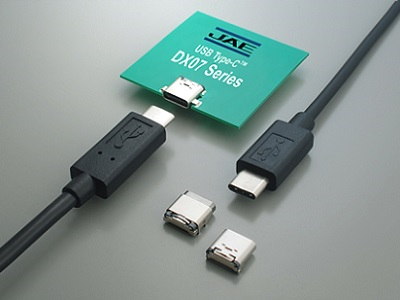JAE Electronics With USB Type-C Connector Family
Based on the USB 3.1 spec with 10Gb/s high data transmission
This is a Press Release edited by StorageNewsletter.com on July 2, 2015 at 2:50 pmJAE (Japan Aviation Electronics Industry, Ltd. ) debuts a line of USB Type-C connectors.
Based on the USB 3.1 specification that defines the next generation of USB connectors, the DX07 offers all the features this new standard has become known for, including:
-
Small form – The ultra-compact DX07 is marginally larger than micro USB connectors used in today’s phones
-
High speed data transmission – At 10Gb/s, the USB 3.1 Type-C connector is one the fastest small form connectors available
-
Power – Up to 100W
-
Reversible design – Users can connect in either direction.
Ultimately the USB Type-C connector will be universal. For example, today’s bigger devices use standard USB connectors; smaller devices use Micro USBs. Ultimately, all devices will use USB Type-C connectors.
“We were one of the first interconnect companies invited by the USB-IF to participate in the development of the USB Type-C connector,” said Glenn Griffin, VP, JAE Electronics. “Our people know first-hand the enhanced capabilities of this new standard and we are excited to be among the first to offer a full line of these components.“
Additional features of USB Type-C connector embodied in DX07 family include:
-
Friction lock equipped – Friction lock housed inside of connector is not visible or exposed to the environment presenting a much cleaner looking plug/cable connector.
-
EMI Reduction – Special ground spring contacts connecting the plug and receptacle shells substantially reduce EMI levels.
-
Supports power delivery (3A/5A) – Most legacy connectors require some modification to facilitate power delivery. But Type-C connectors transmit higher current without modifications because Type-C connectors divide power over several contacts.
Future developments for the USB Type-C connector include adding the capability to support alternate modes of information. Ultimately, the goal is that a single Type-C USB port enables all connections.
According to USB-IF, 2016 shipments of USB 3.0 and 3.1-enabled devices will hit 2.1 billion units, up from 684 million units in 2014. Strategy Analytics estimates that Type-C connectors will be featured on 12% of mobile handsets by 2016.













 Subscribe to our free daily newsletter
Subscribe to our free daily newsletter
